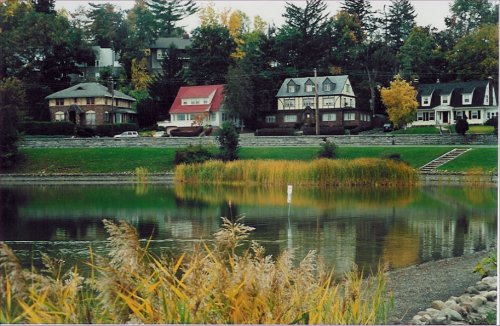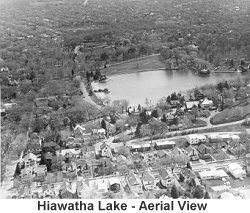Strathmore |
|
The Greater Strathmore neighborhood reflects residential tastes from the late 19th century through the 1920's, showcasing the eclectic styles of Late Victorian, Colonial Revival, and Arts & Crafts architecture. In the 1890's, residential development of Syracuse had spread out from the city's core, aided by the construction of electric street railways. To the southwest, this growth followed major streets like South Avenue, West Onondaga and Bellevue Streets, moving toward South Geddes Street. This area had been farmland through much of the 19th century. Its elevation above the city proper had also caused it to be used as a site for early water reservoirs after the Civil War. Eventually, a major reservoir was built on the western edge of the neighborhood in 1894. Today, Woodland Reservoir serves as a second park for the neighborhood, boasting much of its original 19th century architecture and some of the best views available of the city. In the years just after 1900, Summit Avenue was already attracting stately residences and some construction had begun on Robineau Road homes. These sites offered the advantage of the neighborhood's attractive topography, which provides attractive views east toward downtown and the hills south of the city. Lots along adjacent Stolp and Crossett began filling in and the ongoing landscaping of nearby Onondaga Park, especially between 1911 and 1915, was creating an increasingly attractive neighborhood. In 1919,a new residential development named STRATHMORE "By The Park" was formally opened in the area immediately southwest of Upper Onondaga Park, centered on Strathmore and Charmouth Drives. Most homes had yet to be built, but construction was soon underway.
Onondaga Park, itself, had been given birth by the 1894 opening of the Woodland Reservoir on South Geddes Street, three blocks to the west. Woodland made the area's old Wilkinson Reservoir obsolete and in 1898, the 71 acres surrounding the latter was acquired by the city to form Onondaga Park. In 1903, a large wooded area known as the Olmstead Grove was added, expanding the Park and creating a popular picnic area at its southeast corner that is still in use today. Wilkinson Reservoir was reconfigured in 1911 and renamed Hiawatha Lake, the landscaped centerpiece of today's Onondaga Park.
The neighborhood's annual Strathmore House Tour is one of the most popular in upstate New York. It helps foster preservation of the Park, and the maintenance of the neighborhood's irreplaceable architecture. IT also draws the neighborhood together as hundreds of volunteers work together to foster a spirit of pride within the area. *Photos provided by the Onondaga Historical Association. |
 Colonial
Revivals, Tudors and stylish Arts & Crafts homes appeared. They spread east,
north west and south of the Park, the core of today's Greater Strathmore
Neighborhood. Leading local architects like
Colonial
Revivals, Tudors and stylish Arts & Crafts homes appeared. They spread east,
north west and south of the Park, the core of today's Greater Strathmore
Neighborhood. Leading local architects like
 From
1915 to the mid-1950's, Onondaga Park was known for its major flower beds
and the entire Lake was used for swimming in the summer and ice-skating in
winter. It lost some of its luster in the 1960's and early 70's as the
landscaping aged and maintenance costs escalated for the city. A renewed
effort to improve and enhance the historic landscape of the Park began in
the late 1970's and early 80's. It became a joint public-private effort,
with the Onondaga Park Association working together with the city to raise
funds and focus volunteer efforts toward the Park. A high point occurred in
1987 when the Syracuse City Council dedicated the entire Park as an official
Syracuse Historic Preservation District. Since then, the bandstand has had
major renovations and several plantings have been added. Both Upper and
Lower Onondaga Park remain the focus of neighborhood involvement and
activity.
From
1915 to the mid-1950's, Onondaga Park was known for its major flower beds
and the entire Lake was used for swimming in the summer and ice-skating in
winter. It lost some of its luster in the 1960's and early 70's as the
landscaping aged and maintenance costs escalated for the city. A renewed
effort to improve and enhance the historic landscape of the Park began in
the late 1970's and early 80's. It became a joint public-private effort,
with the Onondaga Park Association working together with the city to raise
funds and focus volunteer efforts toward the Park. A high point occurred in
1987 when the Syracuse City Council dedicated the entire Park as an official
Syracuse Historic Preservation District. Since then, the bandstand has had
major renovations and several plantings have been added. Both Upper and
Lower Onondaga Park remain the focus of neighborhood involvement and
activity.  During recent years, people
were also re-discovering the outstanding historic architecture that
surrounds the Park and helps define the distinctive character of the
neighborhood. The Park's paths, lake, bandstand, basketball courts, picnic
pavilion, playground, pool, tennis courts, plantings and trees provide
recreation and relaxation for thousands. The surrounding houses provide
important links to the craftsmanship, the artistry and the people of our
past.
During recent years, people
were also re-discovering the outstanding historic architecture that
surrounds the Park and helps define the distinctive character of the
neighborhood. The Park's paths, lake, bandstand, basketball courts, picnic
pavilion, playground, pool, tennis courts, plantings and trees provide
recreation and relaxation for thousands. The surrounding houses provide
important links to the craftsmanship, the artistry and the people of our
past.